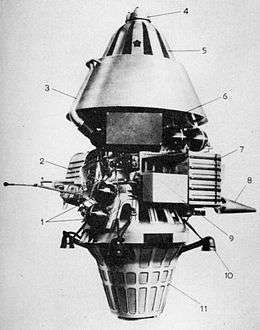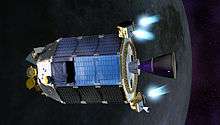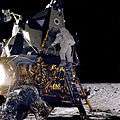Luna 11
 Luna 11 | |
| Mission type | Lunar orbiter |
|---|---|
| COSPAR ID | 1966-078A |
| Mission duration | 38 days |
| Spacecraft properties | |
| Spacecraft type | E-6LF |
| Manufacturer | GSMZ Lavochkin |
| Launch mass | 1,640 kilograms (3,620 lb) |
| Start of mission | |
| Launch date | August 24, 1966, 08:09:00 UTC |
| Rocket | Molniya-M 8K78M |
| Launch site | Baikonur 31/6 |
| End of mission | |
| Last contact | October 1, 1966 |
| Orbital parameters | |
| Reference system | Selenocentric |
| Semi-major axis | 2,414.5 kilometres (1,500.3 mi) |
| Eccentricity | 0.22 |
| Periselene | 1,898 kilometres (1,179 mi) |
| Aposelene | 2,931 kilometres (1,821 mi) |
| Inclination | 27 degrees |
| Period | 178 minutes |
| Lunar orbiter | |
| Orbital insertion | August 27, 1966, 21:49 UTC |
| Orbits | 277 |
| Instruments | |
|
Imaging system for lunar photography Gamma-ray spectrometer Magnetometer Radiation detectors Infrared radiometer Meteoroid detector R-1 transmission experiment | |
Luna 11 (E-6LF series) was an unmanned space mission of the Soviet Union's Luna program. It was also called Lunik 11. Luna 11 was launched towards the Moon from an earth-orbiting platform and entered lunar orbit on 27 August 1966.
Overview
The objectives of the mission included the study of:
- lunar gamma and X-ray emissions in order to determine the Moon's chemical composition;
- lunar gravitational anomalies;
- the concentration of meteorite streams near the Moon;
- the intensity of hard corpuscular radiation near the Moon.
137 radio transmissions and 277 orbits of the Moon were completed before the batteries failed on 1 October 1966.
This subset of the “second-generation” Luna spacecraft, the Ye-6LF, was designed to take the first photographs of the surface of the Moon from lunar orbit. A secondary objective was to obtain data on mass concentrations (“mascons”) on the Moon first detected by Luna 10. Using the Ye-6 bus, a suite of scientific instruments (plus an imaging system similar to the one used on Zond 3) replaced the small lander capsule used on the soft-landing flights. The resolution of the photos was 15 to 20 meters. A technological experiment included testing the efficiency of gear transmission in vacuum as a test for a future lunar rover.
Luna 11, launched only two weeks after the U.S. Lunar Orbiter, entered lunar orbit at 21:49 UT on 27 August. Parameters were 160 x 1,193 kilometers. During the mission, the TV camera failed to return usable images because the spacecraft lost proper orientation to face the lunar surface when a foreign object was lodged in the nozzle of one of the attitude-control thrusters. The other instruments functioned without fault before the mission formally ended on 1 October 1966 after the power supply had been depleted.

